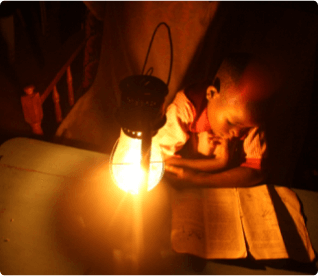
How much light is enough?
Kerosene lamps provide limited light, emit bad-smelling smoke and soot and are plagued with injury and death caused by accidental fires. If one could replace them all with low cost solar lamps, one would remove the danger of accident, and improve rural life. This is essentially the model that drives the market of solar portable lamps.
“Buy a relatively low cost lamp that pays for itself in 3-6 months and provides better, safer light than kerosene and in some cases power for charging your mobile phone.” All good?! We think not.
The philosophy behind KUDURA has always been that just enough light to replace a kerosene lamp is not enough to kick-start sustainable poverty eradication. Alleviating the current pain, it offers little perspective for future economic growth. In Sidonge, Western Kenya, at our pilot project site, we have seen a number of households, obstensibly living off 3€ per day, save up enough to buy a small TV or boom box over the past year. Having scalable power generation and distribution to hand, we simply upgrade their service at home and now, paying a little more every month, they have high quality CFL light in two rooms, can charge mobile phones and power their TV. That access to information & entertainment is power – during the Kenyan election in March 2013, many Sidonge consumers thanked us for the ability to follow the elections in real-time. Thanks to scaleable KUDURA power in their homes.
Our hybrid solar PV mini-grid based approach is an infrastructure play targeted at benefitting the community, local school and clinic comprehensively and is amortised over a longer time period but offers the unique advantage of being able to grow as the population’s needs grow. A recent energy policy guide published by CPAN (the Chronic Poverty Advisory Network), highlights evidence that solar portable lamps fall short of sustainable poverty eradication – they achieve that famed “small step for man” but fail to achieve the “giant leap for mankind” that our KUDURA does.
The core issue is that a single portable solar lamp, while enabling many benefits at home, does not broadly contribute to income generation for the family that owns it. One exception is the case of artisanal fishermen – a good write-up can be found here. To truly eradicate poverty, we need to not only reduce expenses and illness at home but increase income opportunities, something that productive energy use (i.e. using electricity to make products that can be sold at a profit) enabled through KUDURA does. Tying clean energy to increased water and food access, the so-called “food-energy-water nexus”, creates an environment where we can truly enable rural communities to improve their lives sustainably.
What eradication of rural poverty needs is giant leaps forward and step function change – the incremental progress to addressing the problem over the last 50 years has resulted in over 568B$ spent on development with 590M Africans still lacking access to clean energy; this number is further expected to grow (not shrink!) to 700M people by 2030. We believe that the KUDURA approach is one such giant leap.
Read more about our KUDURA solution for schools.
Other relevant links: the CPAN policy brief | the full CPAN energy policy guide
